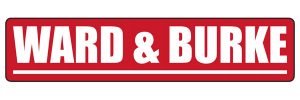Lobwood Fish Pass (2020)
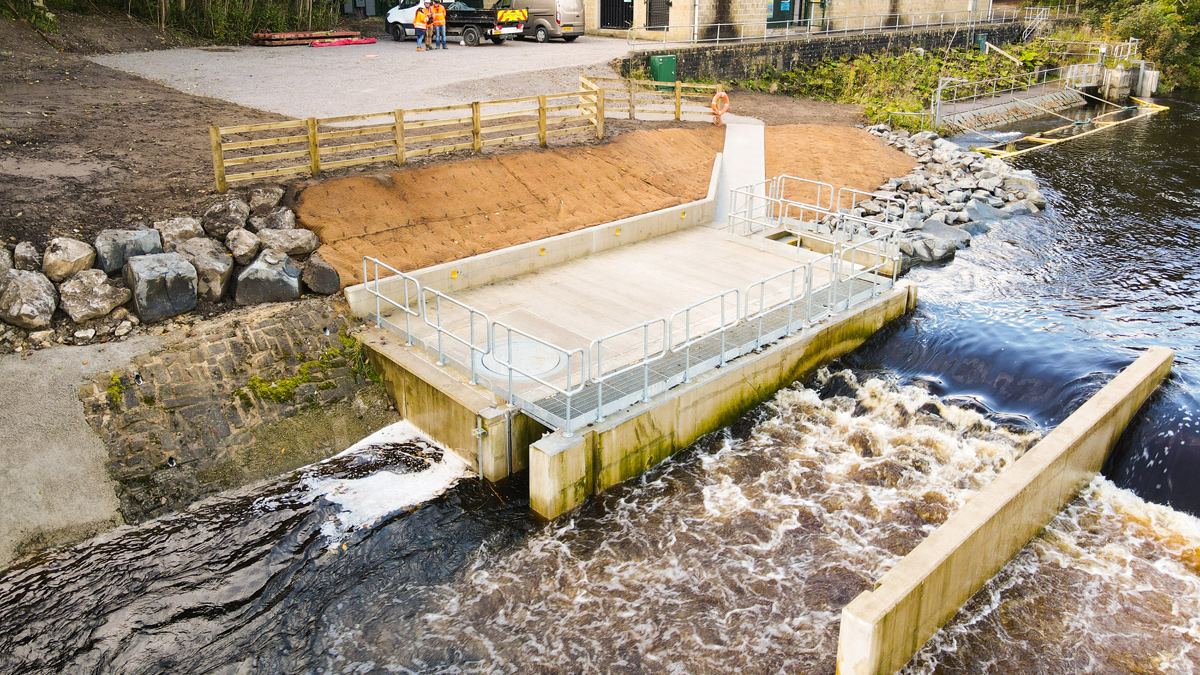
Lobwood Fish Pass operation on the River Wharfe - Courtesy of Ward and Burke
All freshwater fish species in England undergo migration in one form or another, ranging from movements pertaining to feeding and refuge habitats over the course of a day, to longer journeys (for example, between freshwater and marine habitats) on a less frequent basis. Between 2015-2020, Yorkshire Water, in partnership with the Environmental Agency as part of a much wider programme of work to comply with the National Environment Programme, invested £10m in the creation of 13 new fish passes across the Yorkshire region to facilitate all such fish migrations. The primary driver is compliance with the Natural and Rural Communities Act (NERC) 2006 and the EU Water Framework Directive, whilst also aligning with Yorkshire Water’s internal driver to ‘take responsibility for the water environment for good’. Yorkshire Water contracted designers JBA Consulting and Ward & Burke Construction to design and construct an 8.8m long by 3.8m wide fish and eel pass on the River Wharfe, just outside Addingham Village near Bolton Abbey.
Existing weir
Fish passes facilitate upstream and downstream passage for a wide range of freshwater fish species. The existing weir spanned the width of the River Wharfe (approximately 30m) and was located by the intake works at Lobwood Pumping Station. The weir had a V-notch design to draw debris away from the intake works, however this needed to be filled as it would result in turbulent water which provides an attraction for fish.
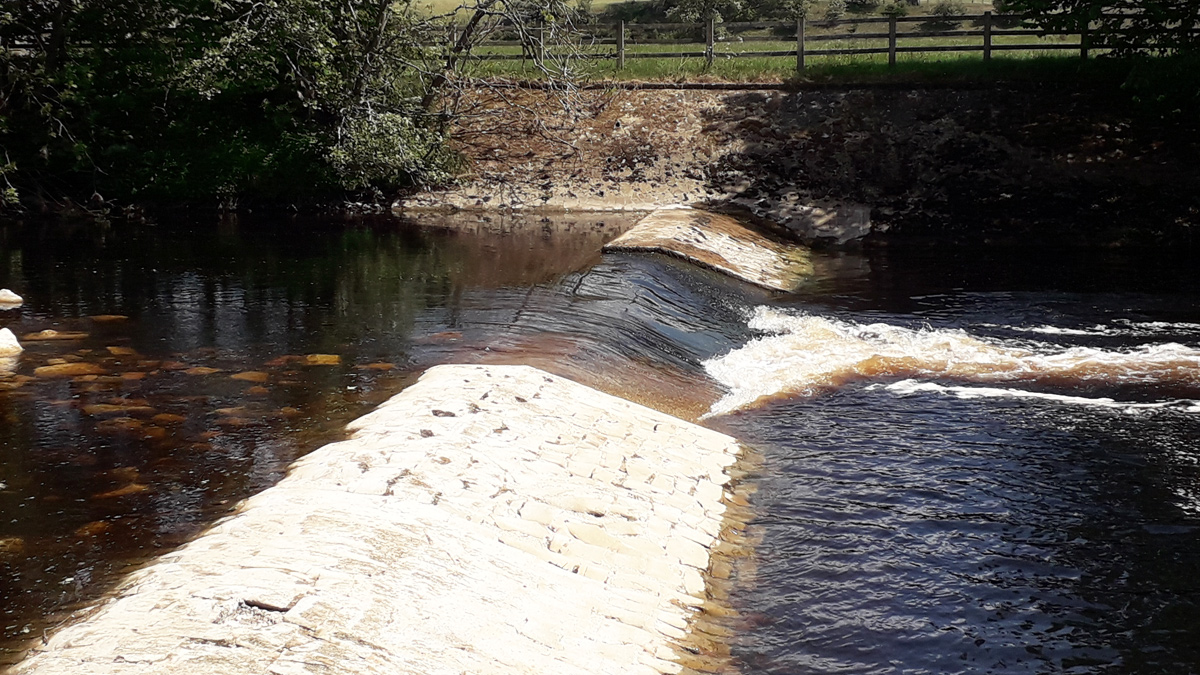
Existing V-notch weir – Courtesy of Ward & Burke
Optioneering and design considerations
The scope of work included the detailed hydraulic and structural design of a single Larinier fish pass (the type of fish pass having already been agreed in principal prior to our appointment) against the right bank.
The new fish pass was to be situated on the weir, just downstream of the Lobwood RPS river intake, for the supply of raw water into Chelker ESR and then on to Chellow Heights WTW (which supplies Bradford). Historically, during autumn and winter the intake had issues with leaves and debris so CFD modelling was undertaken to assess the impact of the new fish pass and results indicated that it was likely that the new pass could result in increased build-up of debris. After numerous options to reduce this, it was found that the introduction a rock revetment to slightly alter flow patterns was the best solution to improvement for debris reduction.
Another consideration was an existing live water main that was located within the weir. There was a risk that this could get damaged during the construction of the fish pass and as a result, an additional main would be installed beneath the river downstream of the weir using trenchless technology.
Due to the volatile levels of the River Wharfe, which varied from 89.5mOd to 92.5mOd, the design provided a platform to allow access for maintenance during all weather conditions. The platform level was to be 90.5mOd and when maintenance is required removable handrail can be installed in the pre-formed sockets.
Prior to construction works commencing, an ecology survey was carried out and it was discovered that newts and Himalayan balsam were present downstream of the works area and controls measures were required prior to construction.
Lobwood Fish Pass: Supply chain – key participants
- Principal contractor: Ward & Burke
- Principal designer: JBA Consulting
- Eel and lamprey tile supplier: Berry & Escott Engineering
- Handrailing and access: Steelway
- Larinier baffle fabrication: C&D Engineering
- Legato interlocking blocks: Elite Precast Concrete Ltd
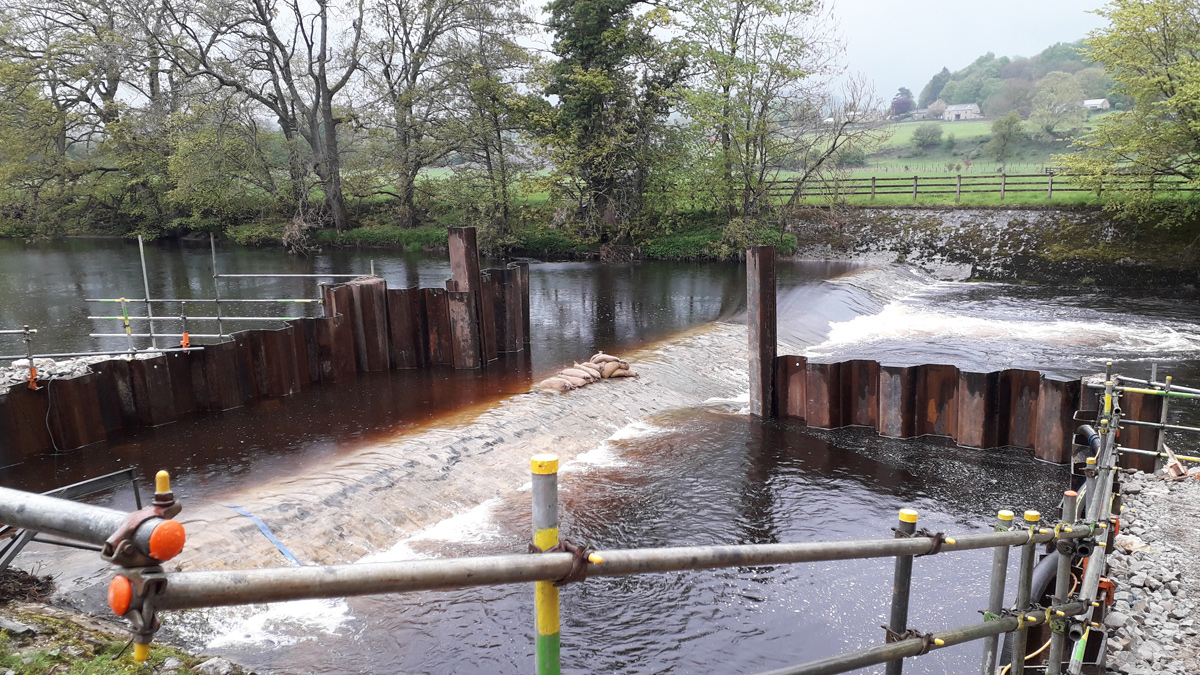
Cofferdam installation – Courtesy of Ward & Burke
Construction of the fish pass
Cofferdam
A sheet piled cofferdam was designed and installed where the fish pass was to be constructed. The sheet piles were 5m interlocking piles installed around the designated works area. However, sheet piles could not be installed in one section due to the existing weir and the water main below, so Legato blocks and large bulk bags were utilised to dam this section of the cofferdam.
The weir level at the location of the fish pass was reduced using a rock wheel to grind down the existing weir to reduce the risk to the water main cast in the weir as it was hoped that this main would be utilised in the future upon completion of the fish pass.
An over-pumping system consisting of 2 (No.) 6” submersible pumps were placed within the cofferdam, plumbed through individual settlement tanks before re-entering the river to ensure all potential sediment picked up in the over pumping process was removed.
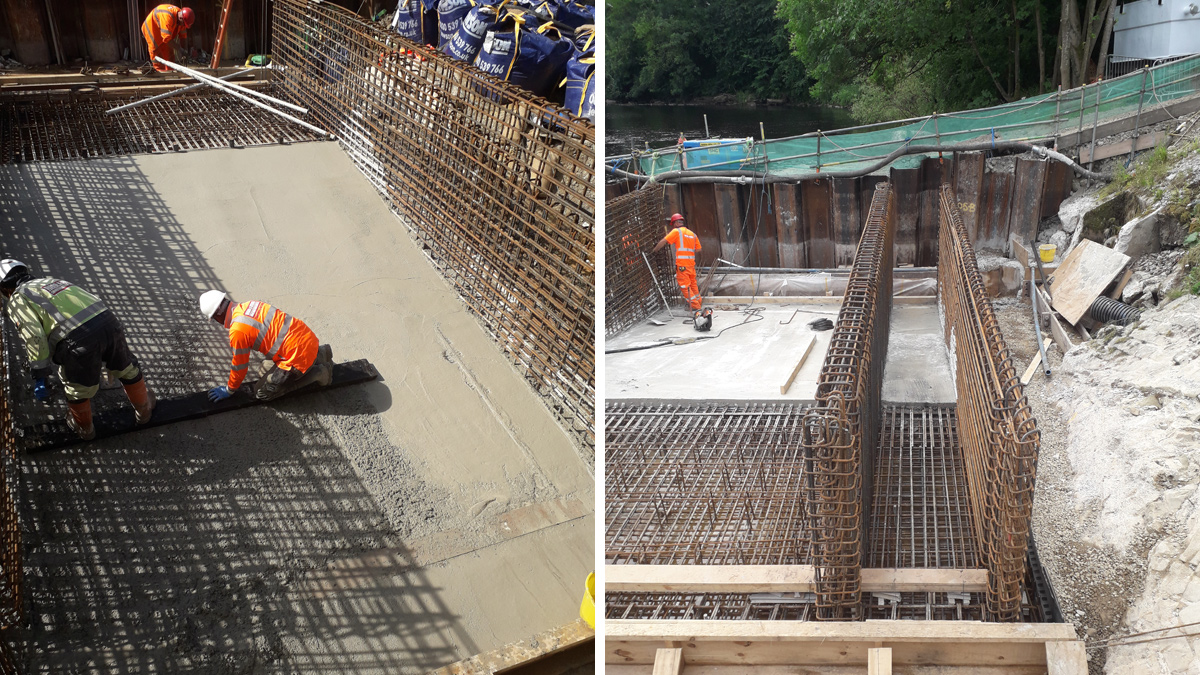
(left) Base construction and (right) wall construction – Courtesy of Ward & Burke
Base and walls
When the area within the cofferdam was pumped dry and under control, the base for the fish pass was excavated and a mass fill C40/50 concrete poured to formation level. Steel reinforcement was then tied for the base, along with the starter bars for the three walls of the fish and eel passes. The base was then poured at a soft 8.5° slope ready for the baffle plates to get positioned at a later date.
For the construction of the walls, the shuttering panels had to be stepped to tie in with the run of the slope. The onsite shuttering joiners made relevant angled shutter bases to integrate with the main wall shutters so each wall could be poured as a whole and finished.
Fish and eel passes – baffles and tiles
The next stage was to pour the angled mass fill within the eel pass which runs parallel to the fish pass, separated by a 400mm RC wall. Due to the steep angle and fall of the pass, the C40/50 concrete had to be of an S2 slump consistency so that it would retain itself while curing and be hand finished to the correct angle.
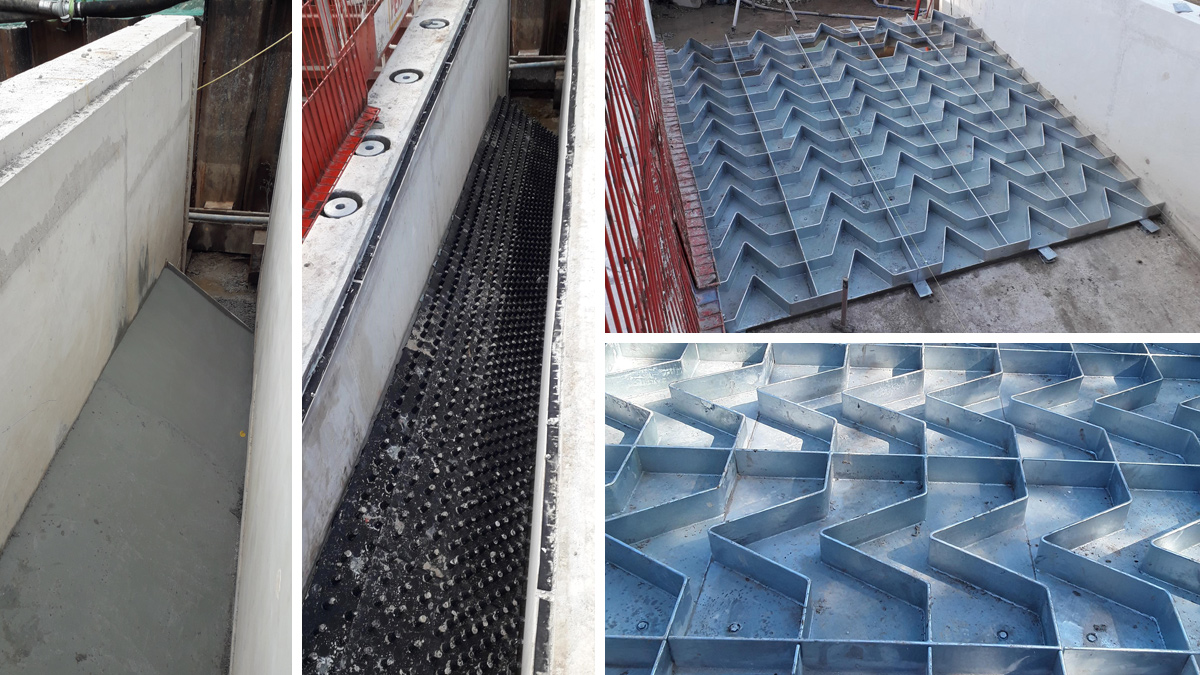
(left) Eel pass concrete pour and with eel tiles installed, and (right) the fish pass Larinier baffles – Courtesy of Ward & Burke
For the eel pass, louvred boss tiles, which are applicable for both eel and lamprey, had to be fixed to the previously poured angled base. These were again fixed to the base and the edges grouted to seal any possible gaps, removing risk of any species getting trapped between the tile and the wall.
The galvanised baffles for the fish pass were fabricated by C&D Engineering, a local firm that has the facilities at their workshop to cut, weld and galvanise the baffles as per set design. It was critical that the shape, spacing and height of the baffles were correct to avoid flow disruptions leading to debris getting jammed within the baffles, making the fish pass ineffective.
These baffle sections were slung at an angle and placed to the grade to ensure accuracy of +/- of 5mm. When these were all in position and fixed to the base, a mass grout pour was applied to the underside of the all the baffles to ensure they were fully sealed.
Surveys and inspections
Surveys and inspections of the fish pass by JBA Consulting and the Environment Agency concluded that the overall design and construction of the structure was satisfactory and came within the design specification. On confirmation of this, the sheet piles and over-pumping system was removed from the river to allow flows through the new passes.
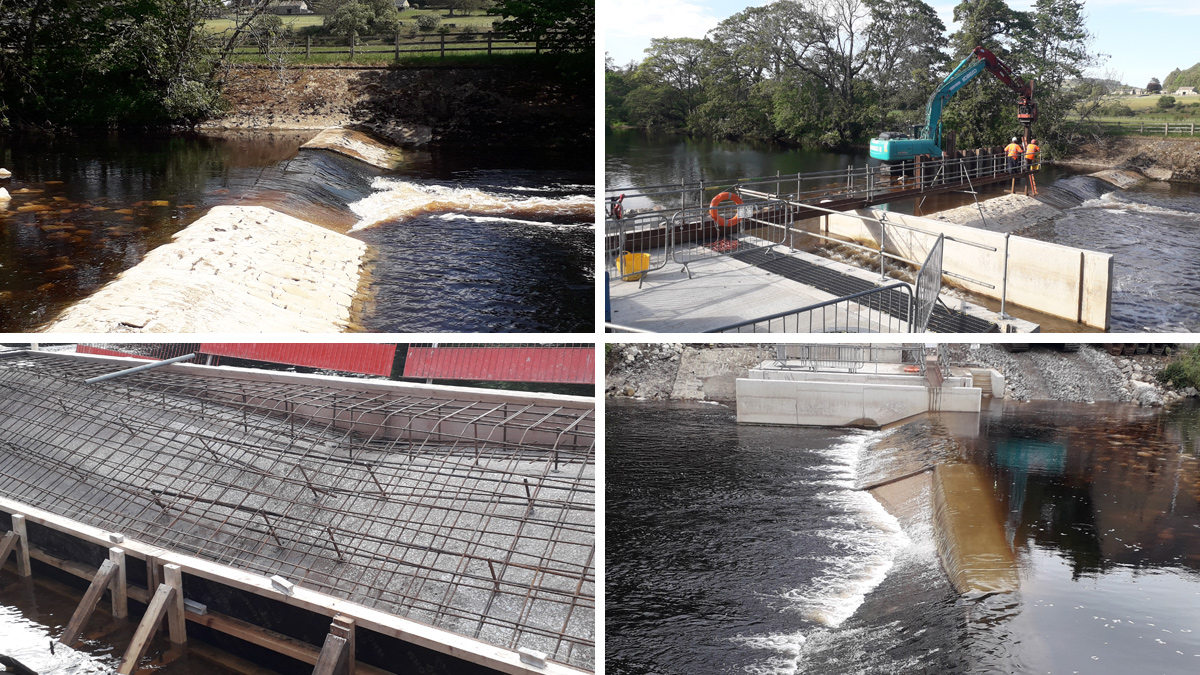
(top left) Existing V-notch weir, (top right) access walkway to middle of river and (bottom left) V-notch infill works and (bottom right) the completed infill V-notch – Courtesy of Ward & Burke
V-notch infill
Upon commissioning of the fish pass, the existing V-notch weir in the middle of the river was infilled to ensure the water flow is diverted to the fish pass, providing turbulent waters to attract fish.
Sheet piles were installed to divert flow and a temporary access walkway was installed providing safe access to the work area. The surface on the original v-notch was then prepared and steel reinforcement was installed for pouring the infill.
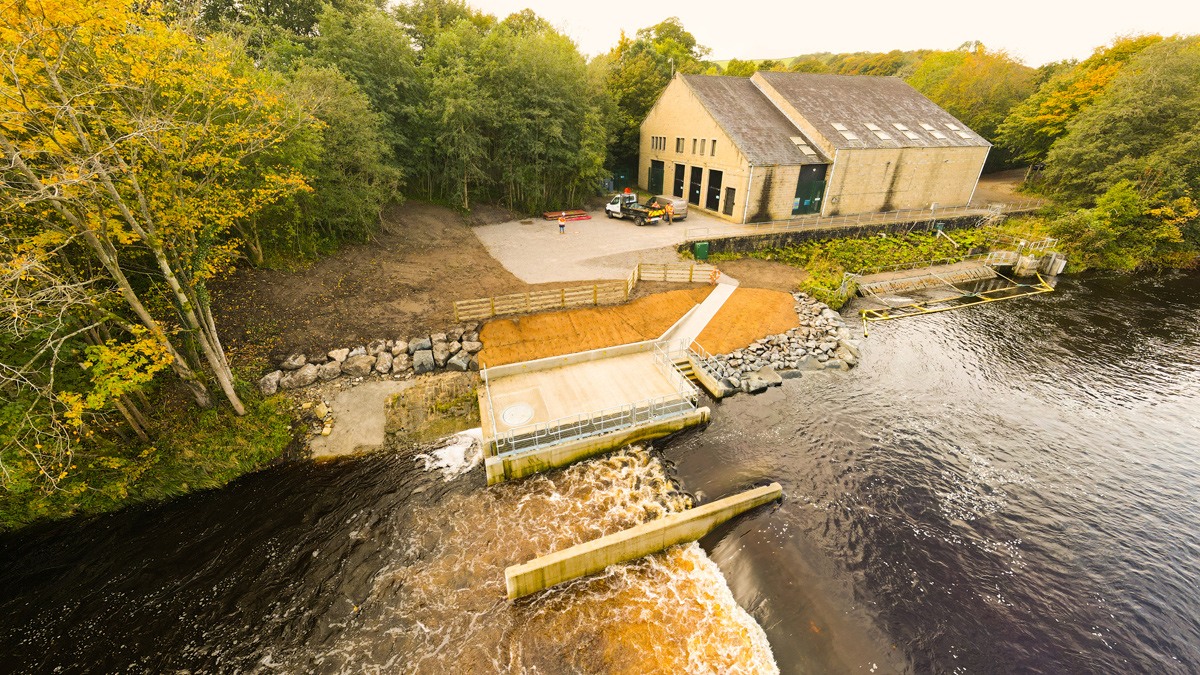
The completed Lobwood Fish Pass – Courtesy of Ward & Burke
Completion
Lobwood Fish Pass was completed in July 2020.




